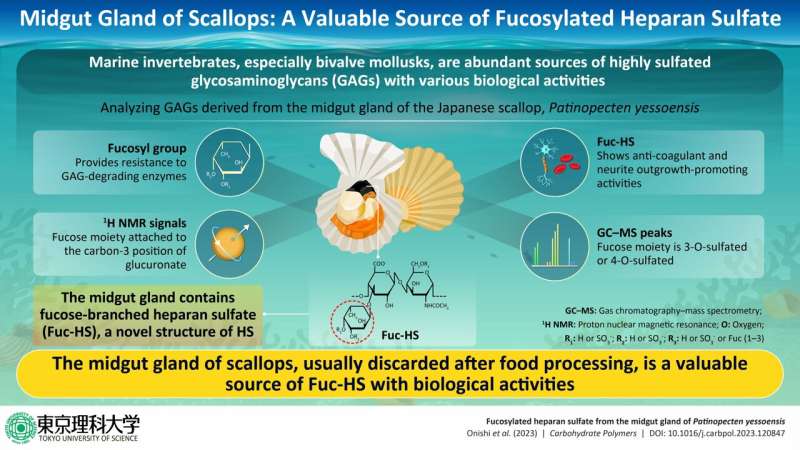Midgut gland of scallops: A valuable source of fucosylated heparan sulfate

Glycosaminoglycans (GAGs), including chondroitin sulfate (CS), heparan sulfate (HS), heparin, and hyaluronan are linear and acidic polysaccharides found in the extracellular matrix of all animal tissues. GAGs are widely used as functional ingredients in health products, pharmaceuticals, and cosmetics, and are prepared from biological samples such as shark cartilage and porcine intestinal mucosa. Consequently, the demand for new sources of GAGs is ever-present.
For example, the supply source of the anticoagulant heparin—generally prepared from porcine intestinal mucosa in China—was threatened by African swine fever in 2018.
GAGs derived from marine invertebrates—animals without a bony skeleton—such as bivalve mollusks are highly sulfated or branched with neutral sugars. These modifications enhance their properties and enable them to perform various biological activities. In fact, heparin-like polysaccharides with anticoagulant activity were identified from some kinds of bivalve mollusks.
In this light, a group of researchers led by Dr. Kyohei Higashi, Associate Professor at the Faculty of Pharmaceutical Sciences at the Tokyo University of Science (TUS), has investigated the structure and biological activities of GAGs derived from the midgut gland of the Japanese scallop, Patinopecten yessoensis, a bivalve mollusk.
Their work, made available in Carbohydrate Polymers, is co-authored by Dr. Takeshi Wada and Dr. Kazuki Sato of the TUS and Dr. Shinji Miyata of the Tokyo University of Agriculture and Technology.
Dr. Higashi briefly discusses the motivation behind the present research. “Scallops are among the most popular marine ingredients in Japan. While their adductor muscle and mantle are edible, their midgut gland, a potential cadmium accumulator, is usually discarded as waste during food processing. However, it may be a promising abundant source of GAGs, whose structures remain unexplored.”
In this study, the researchers extracted crude GAGs from the midgut gland of the Japanese scallop, fractionated them by anion exchange chromatography, and analyzed their structures through high-performance liquid chromatography (HPLC), proton nuclear magnetic resonance (1H NMR), and gas chromatography–mass spectrometry (GC–MS) techniques. HPLC revealed that HS, which showed resistance to GAG-degrading enzymes such as chondroitinases and heparinases, is the major GAG present in the gland.
However, its resistance to heparinases decreased upon mild acid hydrolysis, hinting at the presence of the fucosyl (Fuc) group. 1H NMR confirmed the same. It detected significant signals corresponding to the H-6 methyl proton of Fuc and small signals corresponding to H-2 or H-3 of glucuronate (GlcA) present in HS, showing that Fuc is attached to the C-3 position of GlcA.
Furthermore, GC–MS detected peaks corresponding to 1, 3, 5-tri-O-acetyl-2, 4-di-O-methyl-L-fucitol and 1, 4, 5-tri-O-acetyl-2, 3-di-O-methyl-L-fucitol, enabling researchers to conclude that Fuc is 3-O- or 4-O-sulfated.
Lastly, the study highlights that Fuc-HS shows biological activities such as anticoagulation or blood clot prevention and neurite—a projection from the nerve cell—outgrowth promotion.
“These findings indicate that the midgut gland of scallops is a valuable source of Fuc-HS with novel functions. A more detailed investigation of the structure and biological activities of Fuc-HS might reveal its other potential applications, similar to the fucosylated chondroitin sulfate (Fuc-CS) that shows antiviral, anti-diabetic, anti-tumor, and immunomodulatory effects,” points out Dr. Higashi.
The researchers expect the present study to help facilitate the comprehensive analysis of the structure and functions of naturally occurring and biologically active GAGs derived from unutilized sources, which may provide hints for developing glycoside drugs.
More information:
Shoichi Onishi et al, Fucosylated heparan sulfate from the midgut gland of Patinopecten yessoensis, Carbohydrate Polymers (2023). DOI: 10.1016/j.carbpol.2023.120847
Citation:
Midgut gland of scallops: A valuable source of fucosylated heparan sulfate (2023, June 15)
retrieved 16 June 2023
from https://phys.org/news/2023-06-midgut-gland-scallops-valuable-source.html
This document is subject to copyright. Apart from any fair dealing for the purpose of private study or research, no
part may be reproduced without the written permission. The content is provided for information purposes only.
For all the latest Science News Click Here
For the latest news and updates, follow us on Google News.

